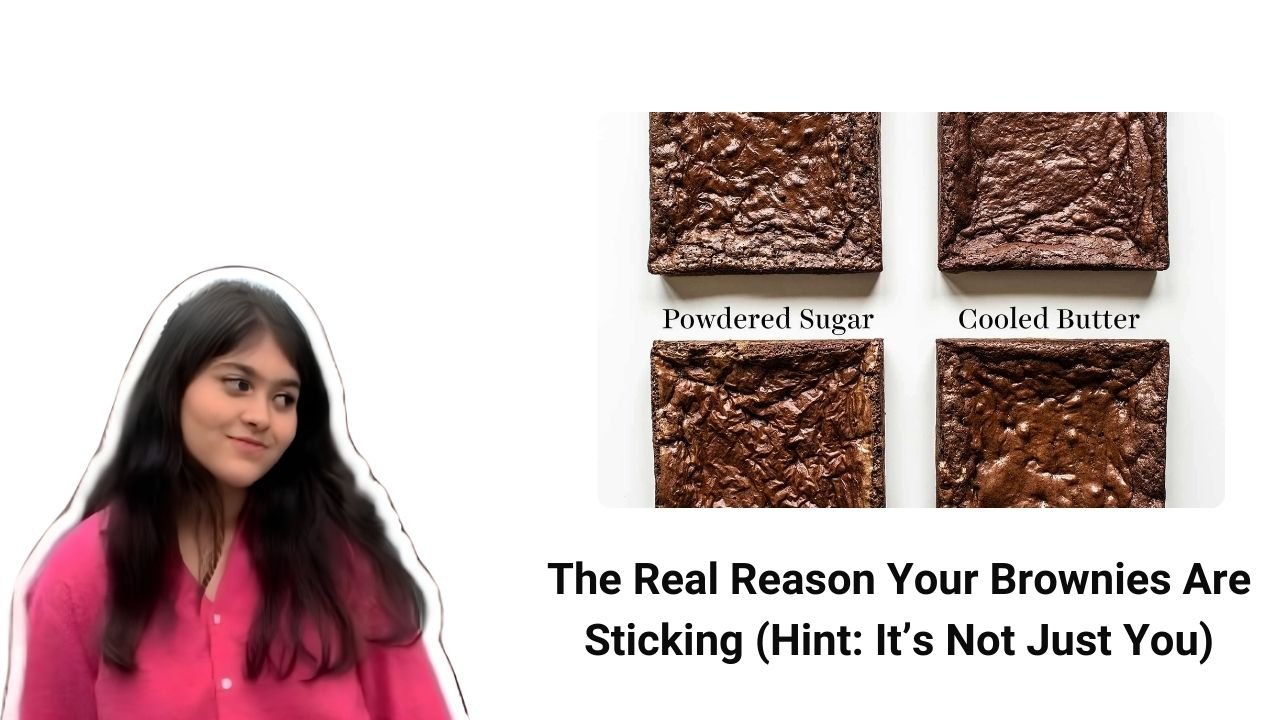Brownie Lovers, We Need to Talk About the Sticky Truth
Few things are as soul-satisfying as a warm, gooey brownie with that perfect chewy edge and soft center. But let’s be real—nothing ruins the moment like half your brownie clinging to the bottom of the pan like it’s refusing to say goodbye. If you’ve ever wrestled with a baking tray, peeling pieces off the bottom like regret from a poor decision, you’re not alone.
In fact, the question of Why Your Brownies Stick — And the Best Pan to Use is more than just a baking annoyance—it’s a rite of passage. Whether you’re a weekend baker or a seasoned pro, sticky brownies are the universal spoiler of dessert dreams. But the good news? It’s a problem that’s fixable with just a bit of know-how and the right tools.
So, let’s dive into what’s really going on when your brownies get stuck, and how to prevent it. Because every square should come out clean, fudgy, and fabulous.
The Real Reason Your Brownies Are Sticking (Hint: It’s Not Just You)

Here’s a truth no one likes to admit: it’s usually not the recipe—it’s the pan. Most brownie recipes are forgiving. It’s your pan prep, pan type, or even how you cool them that can turn a perfect bake into a sticky mess.
Let’s break down the main reasons this happens:
- No barrier between the brownie and the pan: If you forget to grease or line your pan, the batter bakes straight onto the surface.
- Overbaking: A few extra minutes in the oven, and the brownie’s moisture evaporates. This makes the edges glue themselves to the pan.
- Pan material matters: Yes, seriously. Different materials conduct heat differently—and that affects stickiness.
Brownies are dense and fudgy by nature. That means they don’t release as easily as, say, a fluffy sponge cake. If your pan’s surface is dry or not smooth enough, the sugars and fats in the brownie seize and cling as they cool. Think of it like caramel hardening on a cold plate—same science, same frustration.
So if your brownies have been sabotaged by sticking, it’s not you being clumsy—it’s likely the pan not doing its part.
Grease, Line, or Both? Let’s Talk Pan Prep

Think of pan preparation like insurance for your brownies. Skipping it is like driving without a seatbelt—it might be okay sometimes, but eventually, you’ll hit a bump.
The most reliable way to prevent sticking is a two-step method:
- Grease the pan thoroughly with butter, shortening, or non-stick spray.
- Line it with parchment paper, letting a bit hang over the sides so you can lift the brownies out cleanly.
Greasing alone can work, but only on non-stick surfaces. Even then, baked-on sugar can burn and cling to the pan, especially at the corners. That’s where parchment comes in. It acts as a barrier and makes cleanup effortless.
If you’re wondering how to keep brownies from sticking without parchment paper, your best bet is to:
- Use a high-fat greasing method (butter or shortening).
- Dust with a light layer of flour or cocoa powder (for chocolate-based recipes).
- Use a high-quality non-stick pan.
But truly, parchment is the MVP of brownie baking. If you’re skipping it, you’re taking unnecessary risks.
Pans: The Unsung Heroes (Or Villains) of Brownie Baking

Now, let’s talk about the core of the issue: the pan itself. The choice between metal, glass, ceramic, and silicone can drastically affect how your brownies bake—and whether they’ll stick.
Here’s a breakdown table for quick comparison:
| Pan Type | Heat Conduction | Stick Risk | Baking Time | Best Use |
| Metal (Aluminum) | Excellent | Low (if greased) | Standard | Crispy-edged brownies |
| Glass | Moderate | Medium | Add +5 mins | Even baking, soft center |
| Ceramic | Moderate | Medium-high | Add +5–8 mins | Moist, fudgy brownies |
| Silicone | Poor | Low | Longer | Sticky or delicate bakes |
Metal Pans
The best pan for brownies—glass or metal? The short answer? Metal. Especially light-colored aluminum. It heats fast, cools quickly, and helps create those coveted chewy edges. Non-stick coated versions are even better. Just don’t use dark metal unless you reduce the oven temp slightly—it gets too hot too fast.
Glass Pans
Glass pans are pretty but slow to heat. This means your brownies bake unevenly unless you add a few minutes. On the flip side, they retain heat well, so they keep brownies warm longer after baking. The downside? They’re prone to sticky edges unless you grease them well.
Ceramic Pans
Ceramic pans look elegant and offer even heating, but they take longer to warm up and cool down. If you’re asking how long to cook brownies in ceramic pan, add 5–8 minutes to your usual bake time and keep an eye out for dry edges.
Silicone Pans
Silicone is non-stick by nature, which makes it great for easy release. But because it doesn’t conduct heat well, your brownies might not bake as evenly or brown on the bottom. Still, for sticky batters, it’s a good tool. Just place it on a metal tray for stability.
Size Matters: Choosing the Right Dimensions
Let’s talk brownie pan sizes. Yes, this matters more than most people think. The pan size affects bake time, thickness, and texture.
Here are common sizes:
- Brownie pan size 8×8: Great for thick, fudgy brownies. Bake at 325–350°F for 35–45 minutes.
- Brownie pan size 11×7: Offers slightly thinner brownies with a bit more chew. Bake at 325–350°F for 30–40 minutes.
- 9×13 pans: Ideal for larger batches or cake-like textures. Cut time down slightly if recipe is written for 8×8.
If you pour an 8×8 recipe into a 9×13, the batter spreads too thin, bakes too fast, and dries out. On the flip side, using a small pan for too much batter makes the center undercooked. Stick to the recommended size or adjust your timing accordingly.
Need a pro tip? Use an all edges brownie pan if you’re obsessed with chewy corners (like me). These pans give every brownie that crisp bite while still keeping the center soft. They’re a game-changer.
Cooling and Cutting: The Final Stretch That Makes All the Difference
Even if you’ve done everything right—prepped the pan, picked the perfect material, nailed the timing—you can still ruin your brownies if you rush the final steps. Yes, we’re talking about cooling and cutting.
When brownies come out of the oven, they’re still setting internally. If you try to remove or slice them while they’re hot, they’ll tear, stick, and crumble. The sugars are still fluid, and the structure hasn’t firmed up.
Here’s how to finish strong:
- Let the pan cool completely—at least 1 hour.
- Use a plastic or silicone knife to cut, especially if you used a non-stick or glass pan. Metal knives can scratch your bakeware.
- For ultra-clean edges, chill the brownies in the fridge for 30 minutes before cutting. Wipe the blade between slices for sharp presentation.
Cooling is like letting your brownies catch their breath before the big reveal. Don’t skip this—it’s the secret to getting those perfect, bakery-style squares.
What If You Forgot the Parchment? Hacks to Save Your Batch
Sometimes we forget. You’re halfway through pouring your beautiful batter when you realize you skipped the parchment paper—or the greasing. Don’t panic! You might still have options.
Here are a few quick rescue tips for sticky brownie situations:
- Warm the pan slightly: Pop it back in the oven for a couple minutes. This softens the base and makes it easier to release.
- Use a flexible spatula: Gently slide it under the brownies. Work slowly from the edges to the center.
- Flip with confidence: If the batch is fully cooled, try placing a cutting board on top and flipping the pan to release the slab, then cut.
If all else fails, just grab a spoon and call it a brownie crumble. Top it with ice cream. You didn’t fail—you created a deconstructed dessert.
Material Deep Dive: Which Pan Wins the Brownie Crown?
If we had to crown a winner in the world of brownie pans, here’s how each type stacks up when we weigh all the factors:
| Pan Type | Pros | Cons | Stick Potential |
| Metal (Aluminum) | Fast heat-up, crisp edges, even bake | Can discolor or warp over time | Low |
| Glass | Even heating, visible doneness | Slower bake, may stick | Medium |
| Ceramic | Elegant, retains heat | Heavy, slow to heat | Medium |
| Silicone | Super non-stick, flexible, dishwasher safe | Poor heat conduction, soft texture | Low |
| Non-stick Metal | Best of both worlds | Coating may wear off | Very low |
So, when answering the question of best pan for brownies: glass or metal, the clear champion is metal, especially non-stick aluminum. It gives you those caramelized edges, moist centers, and clean release—if you prep it right.
But every material has its strengths. For example:
- Use glass or ceramic when you want a softer, more evenly baked center.
- Use silicone when you’re working with delicate or sugar-heavy batters that are more prone to sticking.
Brownie Pan Reviews and Real-Life Favorites
Let’s highlight a few pans that come highly recommended from home bakers and pros alike:
- USA Pan 8×8 Nonstick Square Pan
- Heavy-duty aluminized steel
- Non-stick silicone coating (PTFE-free)
- Excellent durability and easy release
- Pyrex Glass 8-Inch Square Pan
- Affordable and classic
- Easy to monitor browning
- Needs extra greasing or parchment
- Wilton Silicone Brownie Mold
- Great for portioned brownies
- Ultra non-stick
- Needs support tray when filling
- Baker’s Edge All Edges Brownie Pan
- Fun design for chewy-edge lovers
- Heats evenly with multiple edge zones
- Best for thicker batters
Real people on Reddit and baking forums constantly debate “best all edges brownie pan” or the “best size pan to bake brownies”, but ultimately it comes down to personal texture preference. Do you love a soft center or crispy corners? Your choice in pan can customize the experience every time.
A Brownie-Saving Summary: Your Must-Know Takeaways
If you’ve ever asked yourself, “Why are my brownies always sticking?” now you know it’s more than just bad luck. It’s about strategy.
Here’s your brownie baking cheat sheet:
- Always prepare the pan—grease + parchment is your power combo.
- Choose the right material: Non-stick metal is the MVP for crispy edges.
- Know your size: Match the recipe to an 8×8 or 11×7 pan for best results.
- Let them cool completely before cutting.
- Adjust time based on pan—glass and ceramic = slower baking.
And remember: It’s okay to fail sometimes. Brownies are forgiving. Even a broken batch can still be delicious with a scoop of vanilla on top. What matters is that you enjoy the process—and get better every time.
Final Thoughts: The Brownie Battle Is Yours to Win
Baking is part science, part art, and part heart. Whether you’re baking for a birthday, a breakup, or just because Tuesday felt like a brownie kind of day, your pan choice can elevate or sabotage the outcome.
So next time you preheat that oven, pause for a second. Think about your pan. Prep it with love. Because understanding Why Your Brownies Stick — And the Best Pan to Use isn’t just about avoiding mess—it’s about mastering the craft.

Hey, I’m Nandoza Ahammad, passionate food enthusiast and creator of narzcookingcave.com, shares delicious recipes and cooking tips worldwide.

